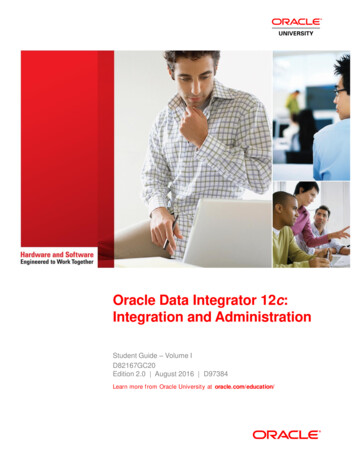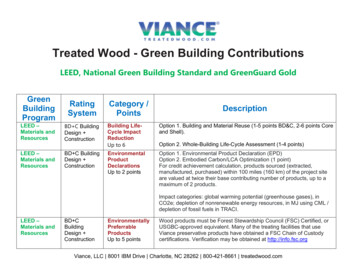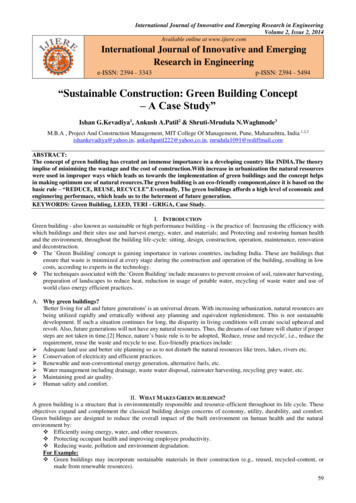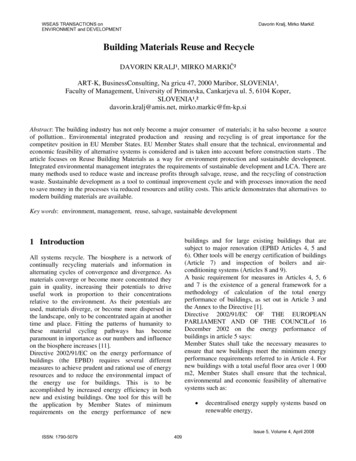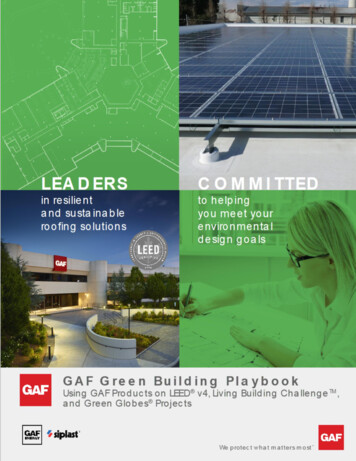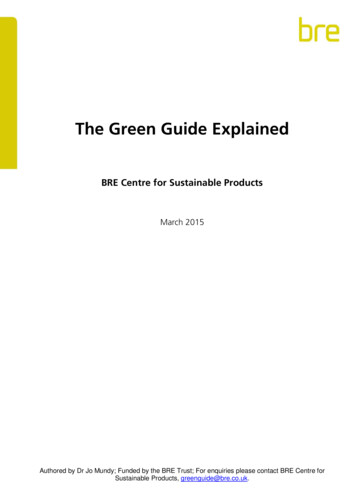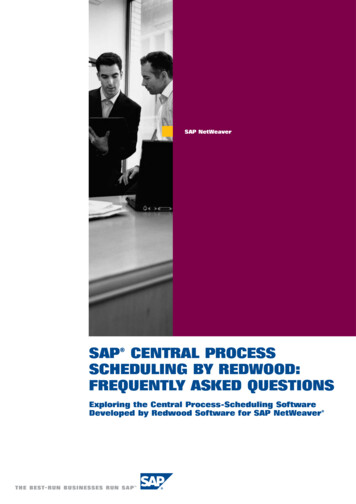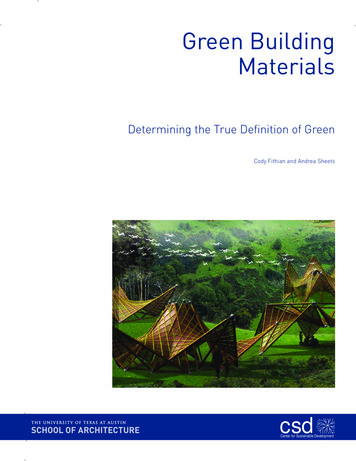
Transcription
Green BuildingMaterialsDetermining the True Definition of GreenCody Fithian and Andrea SheetscsdCenter for Sustainable Development
UTSoA - Seminar in Sustainable ArchitectureGreen Building MaterialsCody FithianAndrea Sheetsmain picture of presentationFig. 01 Survey conducted by National Geographic and international polling firm Globescan to 17,000 consumers on a variety ofissues measuring their eco-friendliness.What does “green” really mean?“Going Green” seems to be the newand popular thing to do. It is an easystatement to make, but gives verylittle detail of how one will addresssuch a global issue.There are currently over fifty regionaland national green labeling programsthroughout the United States. Eachof these have similar yet quitedifferent versions of rating systemsand qualifying characteristics thatthey look for in a green building.Some focus on only the end resultsand completely overlook whathappens during the gathering andmanufacturing of materials. Otherslook more heavily at issues ofeconomics and energy savingswhile deeming other issues like thedistance a material travels or thetoxins it could emit into the air asmuch less important.As long as a material has atleast one positive impact on theenvironment, it could be defined asgreen. However when analyzedmore carefully, this same materialcould actually be harming theenvironment more than it is helping.Therefore it is extremely important toknow who is labeling a material asgreen. Many labeling organizationsare sponsored by material industriesand will consequently be lenientin granting those materials greenstatus. This complicates the processof determining exactly how greenspecific materials are.The trouble in identifying the truestdefinition of green may be that thereis no absolute definition. The lackof public unity in a definition hascaused the meaning to becomeconvoluted and impossible todistinctly pronounce. However,by examining the problems andcorruption of the green labelingindustry, one can indeed gain anunderstanding of the complexityof variables that contribute to thegreenness of a material and how to1
UTSoA - Seminar in Sustainable Architectureapply these principles in design andbuilding.Green Labeling ProgramsThere are over fifty green labelingprograms across the country.1 Thisis an overly abundant number oforganizations who are all in theorysupporting and dealing with thesame things.Some common issues that they alltake into consideration are: Construction techniques Waste reduction/recyclingthrough construction phase The indoor environment and itsuse of environmental products Water-efficient processes Renewable energy options Smart growth and sustainableland development practicesHowever all of the programs weighthe importance of these issuesdifferently and consequentlyestablish their own unique checklists.The decision of which mattersare more important to a specificlabel often stems from the desiresof sponsors and investors. If alabeling program receives fundingfrom another organization, theywill unfairly rate that organization’sproducts as greener than the reallyare.Corruption in the green labelingindustry makes it difficult to discernwhich are the most credible andtrustworthy programs. Knowing whois behind the labeling is the first stepin uncovering truly green materials.Although there are many greenlabeling programs in America, thereare really only a handful that arewell-known. Builders are more2Fig. 02 Some of the many Green Labeling Program logos.likely to choose materials with theseratings. This is because they wanttheir efforts to be widely recognized,and they automatically trust thesecompanies since everyone elseseems to think they are superior.Four of the largest and mostrecognized green labeling programsare: LEED Energy Star Green Globe Green SealEach are administered by differentorganizations, have their own ratingcriteria and focus most heavily ondifferent issues. By looking at allfour of these, one can begin to seeoverlaps and shortcomings. Onecan begin to develop a more holisticapproach to defining a true greenmaterial.
Green Building MaterialsLEEDDefinition an internationally recognizedgreen building certificationsystem provides third-party verificationthat a community or buildingwas designed and built usingstrategies aimed at improvingperformances in energy savings,water efficiency, CO2 emissions/reductions, improved indoorenvironmental quality, andstewardship of resources andsensitivity to their impactDeveloped by the U.S. GreenBuilding Council, LEED providesa framework for implementingmeasurable green building design,construction, operations, andmaintenance solutions. It worksthroughout the building lifecycle.Certification is achieved throughthe third-party independent GreenBuilding Certification Institute.efficient appliances, fixtures andfittings inside and water-wiselandscaping outside Energy and Atmosphere commissioning energy use monitoring efficient design and construction efficient appliances, systems,and lighting use of renewable and cleansources of energy, generated onsite or off-siteInnovation in Design provides bonus points forprojects that use new andinnovative technologies andstrategies to improve a building’sperformance beyond what isrequired by LEED credits orgreen building considerationsthat are not specificallyelsewhere in LEED rewards projects using a LEEDAccredited Professional toensure a holistic, integratedapproach to the design andconstruction phaseMaterials and Resources encourages the selection ofsustainably grown, harvested,produced, and transportedproducts and materials promotes reduction of waste aswell as reuse and recycling takes into account reduction ofwaste at a product’s sourceRating System and CriteriaIndoor Environment Quality promotes strategies that canimprove indoor air as well asproviding access to daylight andviews and improving acousticsSustainable Sites discourages development onpreviously undeveloped land minimizes a building’s impact onecosystems and waterways encourages regionallyappropriate landscaping controls stormwater runoff rewards smart transportationchoices reduces erosion, lightpollution, heat island effect andconstruction-related pollutionLocations and Linkages encourages homes being builtaway from environmentallysensitive areas instead, being built in infill,previously developed, and othersites rewards homes built nearalready-existing infrastructure,community resources and transit encourages access to openspace for walking and physicalactivity and time spent outdoorsWater Efficiency goal is to encourage smarter useof water inside and out water reduction, which istypically achieved through moreAwareness and Education encourages homeowners andreal estate professionals toprovide homeowners, tenants,and building managers witheducation tools they need tounderstand what makes theirhome greenRegional Priority USGBC’s regional councils,chapters and affiliates haveidentified the environmentalconcerns that are locally mostimportant for every region of thecountry, and six LEED creditsthat address those local prioritieswere selected for each region a project that earns a regionalpriority credit will earn one bonuspoint in addition to any pointsawarded for that creditLEED Rating Systems New Construction Existing Buildings: Operations Maintenance Commercial Interiors Core and Shell Schools Retail Healthcare Homes Neighborhood Development3
esWhat LEED deliversWhat LEED IsWhat LEED MeasuresWhatLEEDdeliversHowto getstartedHow to get startedHow to achieve certificationHow to achieve certificationUTSoA- Seminarin reflectSustainableArchitectureLEED pointsaretheirawardedon a environmental100-point scale,and creditsare weightedto reflect their potential environmental impacts. Additionally, 10 bonuspoint scale, andcredits areweightedtopotentialimpacts.Additionally,10 bonuscreditsissues.are available,fourof satisfywhich addressregionallyandspecificissues. A project must satisfy all prerequisites and earn a minimum numberdress regionally specific environmentalA projectmustall prerequisitesearn aenvironmentalminimum numberof points to be certified.GreencertificationBuilding CertificationInstitute and(GBCI)assumes administrationof LEED certification for all commercial and institutional projects registeredute (GBCI) assumes administrationTheof LEEDfor all commercialinstitutionalprojects registeredunderany LEEDRating System. Learn more about the project certification process »more about the project certificationprocess»Thinkof kindit likeofthenutritiondetaillabel abouton a boxcrackers:LEEDsame kind of important detail about the green aspects of a building that,box of crackers: LEED provides thesameimportantthe ofgreenaspectsof aprovidesbuildingthethat,taken together, deliver higher performance.mance.Buildings account for 71% ofAmerica’s electricity use and 38%of all greenhouse gas emissions,according to theDepartment ofSearchEnergy. LEED claims to cut thosenumbers by 25-30%.Sign In Your Account USGBC Store DirectoriesSign In Your Account USGBC Store DirectoriesSearchHomecertificationLEEDIntroHow to achieve certificationWhile this is an improvement, howdoes it compare to the 50% targetHow to achieve certificationHow to achieve certificationadopted by architecture firms thathave signed on to the ArchitectureLEEDpoints areawardedonpotentiala 100-pointscale, and impacts.credits areweighted10to bonusreflect their potential environmental impacts.2030 Additionally,initiative.10 bonus0-point scale, and credits areweightedto reflecttheirenvironmentalAdditionally,suresWhat LEED IsWhat LEED deliversWhat LEED MeasuresWhat LEED deliversHow to get startedHow to get startedcredits are available,of whichregionallyspecificissues.A project must satisfy all prerequisites and earn a minimum numberaddress regionally specific environmentalissues. Afourprojectmust addresssatisfy allprerequisitesandenvironmentalearn a minimumnumberof points to be certified.Furthermore, the limitations of LEEDemanate from its design. The bikerack earns you the same amount ofThink ofit samelike thenutritionlabel ona boxof crackers:providesthe samekind of important detail about the greenpointsaspects ofasa buildingthat, 50% of your energyn a box of crackers: LEED providesthekindof importantdetailaboutthe greenLEEDaspectsof a buildingthat,buyingtaken together, deliver higher performance.ormance.from a renewable source, or thatthere are no regional adjustments;About USGBC Policies & Guidelines Frequently Asked Questions Contactquently Asked Questions Contactsaving water in Seattle earns theCopyright 2009 U.S. Green Building Council. All Rights Reserved.same point as in Tucson. Untilil. All Rights Reserved.recently, you could certify a buildingwith no energy measures.The GreenCertification(GBCI) andassumesadministrationof LEED certification for all commercial and institutional projects registeredstitute (GBCI) assumes administrationofBuildingLEED certificationfor Instituteall commercialinstitutionalprojects registeredunder any LEEDRatingSystem. Learn more about theFigureprojectarn more aboutFigurethe projectprocess»04certification process »03 certificationFigure 06Figure 05Frequently Asked Questions ContactAbout USGBC Policies & Guidelines Frequently Asked Questions Contactuncil. All Rights Reserved.Copyright 2009 U.S. Green Building Council. All Rights Reserved.4The current standard is to beattheASHRAE/IESNA baseline by14%. Shouldn’t all 10 points inthe LEED energy category berequired? Which would meanbeating the ASHRAE standard by42%, which isn’t enough to startsolving the climate crisis. Developersare tempted to pick and choosesustainable solutions in order to earnpoints.2
Green Building MaterialsEnergy StarDefinition A government backedorganization focusing onimproving energy efficiency Administered by the USEnvironmental ProtectionAgency and the US Departmentof Energy Standards for Energy Star ratedbuildings are set by the EPATheir motto is “Energy-efficiencycomes first”. Founded in 1992,Energy Star began as a labelingprogram that only rated consumerproducts. Products like householdappliances and air conditioning unitswith the Energy Star label now savebetween twenty and thirty percent ofenergy.To be rated, you submit data aboutyour building. This informationincludes total square footage,number of occupants, numberof computers, location, etc. Acomputer than takes this data andformulates a figure that would bethe optimal energy spending. Thisis derived from data gatheredby the Department of Energy’sEnergy Information Administration.Then your building is evaluated incomparison to this data and rankedamong its peers. The top twentyfive percent in each building typecategory receive the Energy Starlabel.Currently Energy Star has ratings forthe following building types: Buildings can receive an EnergyStar Label too. To qualify theymust reduce the amount of energyneeded to operate and cause lesscarbon dioxide emissions than otherbuildings of the same type.Rating System and Criteria Bank/financial institutions,courthouses, hospitals (acutecare and children’s), hotels andmotels, K-12 schools, medicaloffices, offices, residencehalls/dormitories, retail stores,supermarkets, and warehouses(refrigerated and nonrefrigerated)Industrial Facilities: automobile assembly plants, cement plants,and corn refineriesMunicipal Water TreatmentPlantsTo determine if a building qualifies tobe Energy Star rated, fifty percent ofthe gross square footage (excludinggarages/parking) must belong to oneof the above categories.3Problems with Energy StarAlthough Energy Star takes a strictapproach to cutting down on energyuse therefore reducing greenhousegas emissions and saving money,it fails to look at materials in depth.They are really only focused on theway that the end product performsin relation to energy savings.Whatever means needed to betaken to get a product a certain way,even if extremely harmful to theenvironment, would be dismissedby Energy Star. Plus there havebeen reports that the organizationsometimes uses loose and outdatedstandards and lets companies ratetheir own products.4Buildings rated on a 1-100 scalein comparison to other buildingsof the same typeA score of 75 or above can earnan Energy Star labelFig. 07 Energy Star LogoFig. 08 Statewide participation rates in the Energy Star program.5
UTSoA - Seminar in Sustainable ArchitectureGreen GlobeDefinition A guidance and assessmentprogram that offers realistic andachievable ways to increasethe sustainability of commercialbuildings Administered by the GreenBuilding Initiative in the U.S.The most important components ofthe Green Globe program are: Comprehensive environmentalassessment protocol Software tools that speed andease online assessment Best practices guidancefor green construction andoperations Experienced green buildingassessors categories: energy, indoorenvironment, site, water,resources, emissions, project/environmental managementCan earn 1-4 globes forachieving at least 350 pointsAfter a building has earned at least350 points, third party independentassessors review buildingdocumentation and walk through thesite. The site walk through is veryintensive and includes a review of allconstruction documentation as wellas the physical walk-through.Buildings that earn green globesshould: use less energy conserve natural resources emit fewer pollutantsRating System and Criteria 1000 point scale in multipleGreen Globe does look at thetotal life cycle assessment of thematerials in the building. This isdifferent from many other labelingprograms that do not look into thesource of the materials and products.They also separate buildings into“new construction” and “continualimprovement of existing buildings”.5Fig. 09 Green Globe logoFig. 10 Green Globe’s Rating System.Green Seal uses the InternationalOrganization for Standardization(ISO) standards for environmentallabeling programs, ISO 14020 and14024.6
Green Building MaterialsGreen SealDefinition a non-profit, third party certifierand standards developmentparty the largest U.S.-basedecolabelling organization the U.S. member of GEN (GlobalEcolabelling Network), whichconsists of 26 of the world’sleading ecolabelling programs develops standards from greencleaning products to lodgingGreen Seal uses life cycleassessment, evaluating productsfrom raw materials extraction tomanufacturing and use to disposal orrecycling. If a product meets GreenSeal standards, it will be awardedthe Green Seal. This organizationworks with the marketplace in aneffort to create a “more sustainableworld”.6Fig. 11 Green Seal Logo.Green Seal EnvironmentalStandards Construction Materials,Equipment and Systems Facility Operations, Maintenanceand Services Hospitality, Lodging and FoodService Home Products and Services Office Products andCommunications Personal Care and ConsumerPackaged GoodsConditionally Green MaterialsThe majority of available greenproducts have one or moreof the following health and/orenvironmental attributes: Promote good indoor air quality(typically through reducedemissions of VOCs) Durable and require littlemaintenance Incorporate recycled content(post-consumer and/or postindustrial) Have been recycled fromexisting or demolished buildings Are made using renewableresources Have low embodied energy Do not containChlorofluorocarbons,Hydrochloroflurocarbons or otherozone depleting substances Obtained from local resourcesand manufacturers For wood or bio-based products,they employ sustainableharvesting practices Recyclable Biodegradablematerials that are claimed to be the“greenest” are missing at least one ofthese attributes. Here are just a fewof such cases:BambooUsually used as flooring, this isthe material that all architectsseem to turn to for a quick additionof sustainability to their designs.However, bamboo is not always thegreenest choice. Although it is arapidly renewable product, the forestthat it comes from is sometimes not.In order to ensure this materialsgreen credibility, it needs to comefrom a FSC source.7In general, a better and greenerflooring material would be rammedearth. It is just as strong and durableas concrete and its source can beat the immediate site. It has ninetypercent less embodied energy thanconcrete also.8Insulated Concrete Forms (ICF)These are stackable blocks ofexpandable polystyrene whichare filled with concrete and re-baras needed. They are strong andextremely well insulated cuttingdown on energy costs greatly.They also get rid of the necessarywood formwork traditionally used inpoured concrete forms. However,the polystyrene is a fossil fuel basedproduct and could contain VOCs.These are extremely harmful to aperson’s health. There is an ICFmade from recycled wood chipscalled “Durisol”, and this would bethe best choice for an ICF wall.9However not many, maybe evennone at all, carry all of thesecharacteristics. Even some7
UTSoA - Seminar in Sustainable ArchitectureLow VOC PaintStructurally Insulated Panels (SIPS)The name says it all. Low VOCis better for the environment andeveryone’s health. However thislabel is misleading. In order to beconsidered “Low VOC”, the paintmust contain less than 250 gramsper liter of the compound. Howevermany companies count the gramsper liter before the pigment is added,which has a large amount of VOC init as well. So these really aren’t whatthey claim to be. The best option forpaint is a Zero VOC paint.10These are wall panels comprisedof rigid foam insulation sandwichedbetween two pieces of orientedstrand board. They can haveinsulative values up to R-60. Thishigh value saves energy andmoney. However, they are usuallynot made of green materials. Somecompanies are now using bio-basedmaterials, but others still usedexpanded polystyrene, which asin ICF can contain VOCs and be ahealth and environmental hazard.12Recycled Denim InsulationThis material is 100% recycled. Sowhat couldn’t be green aboutthat? First, the insulation value isextremely poor (about equal to thatof fiberglass). Second, it causesvapor barrier issues. Third, micelove to live inside of it. Finally, inmost cases the blue jeans usedfor the insulation are shipped allover the country, wasting fuel andnegating the “greeness” of theproduct.11Fig. 12 Insulated Concrete Forms.8Fig. 13 Recycled Denim Insulation.Fig. 14 Structurally Insulated Panels.
Green Building MaterialsConclusionGreen building materials encompassa vast area of topics and materials.The application and use of thesematerials further complicates thesubject.When researching and learningabout all things green, there aresome things to be aware of andwatch out for. First, always check thesponsors for the respective certifyingorganization. You need to beaware of organizations motivesbecause they are not always astransparent as bringing thebest green materials to the nationalstage. Some are more sinister.Asking the question, “Who isprofiting?” can give a strong indicatorof a product or practice’s true level ofgreen value. Green buildingmaterials not only need to benefitthe environment, but with the bestpossible effort manufacturers can putforward. Settling for less underminesthe green effort.Do not look only at the end product.You must consider the energy usedto manufacture products, the wastegenerated, and most important, howthe product is used over its lifetime.Perhaps additional consumption isrequired to maintain the use of aproduct. Also, what happens to theproduct at the end of its lifetime andhow is this method is undertaken?Is the product simply disposed ofor is there potential to re-use andrepurpose the material componentsof the product?The bottom-line is that everythingis conditional, depending on whatframe a product or practice is beinganalyzed through. Be wary ofwebsites that claim to beindependent but haveadvertisements, especially when youare hunting for sustainable materialsand solutions in your area.Green Products Databases Eco-structure Magazine:editorials cover green buildingfrom all angles, providinginformation about rating systemsand diverse green buildingtechniques: http://www.ecostructure.com/Environmental Design Construction Magazine: sourcefor integrated high-performancebuildings: http://www.edcmag.com/EPA ComprehensiveProcurement Guidlines:promotes the use of recycledmaterials in the manufacture ofnew products: ex.htmEPA Environmentally PreferablePurchasing Program’s Databaseof Environmental Informationfor Products and sfGSA Federal Supply Service“Environmental Productsand Services Guide” (20032004): http://www.gsa.gov/gsa/cm attachments/GSA DOCUMENT/2003 4epsg optB(final%20web%20version2) R2OP1-z 0Z5RDZi34K-pR.pdfGuide to Resource EfficientBuilding Elements: http://www.crbt.org/hc3.aspA Sourcebook for Greenand Sustainable Building: acollection of information andsources of materials, assistanceand resources in sustainable solutions: http://sustainablesources.comGreen Building Initiative: a nonprofit organization and the U.S.licensor of Green Globes: http://www.thegbi.orgSustainable Buildings IndustryCouncil: a non-profit organizationthat puts together the “WholeBuilding Design Guide” orcomprehensive applications ofsustainable principles: http://www.sbicouncil.org/Green2Green: comparesbuilding materials’ environmentalperformances: http://www.green2green.orgAlways check locally first!9
UTSoA - Seminar in Sustainable ArchitectureGlossary of Green TermsWhen reading about green materials,certain terms appear quite frequently.This is a greatly summarized list ofsome of those terms.13Carbon Footprint: A measureof an individual’s impact on theenvironment in terms of the amountsof greenhouse gases produced,measured in units of carbon dioxide.Carbon Sink: A natural or manmade reservoir that accumulatesand stores some carbon-containingchemical compound for an indefiniteperiod. Major examples are oceans,forests and landfills.Chlorofluorocarbon: CFC; an organiccompound that contains carbon,chlorine and fluorine. Most widelyfound in refrigerants and aerosols,when released into the air thesecompounds lead to ozone depletion.Embodied Energy: The availableenergy that was used in the workof making a product. This is anaccounting methodology which aimsto find the sum total of the energynecessary for an entire life cycleprocess.Forest Stewardship Council: FSC;A non-profit organization whichpromotes responsible managementof the world’s forests. It setsstandards and independentlycertifies and labels forest productsGreen Products: Products thathave been certified through aprocess of “eco” or “green” labeling,which insures that the product washandled, made or grown underconditions that meet standards ofsustained use, pesticide application10and harvesting as well as certainsocial and economic criteria forworkers.naturally produce and no more. Thisprovides future generations with theassurance of these resources.Greenwashing: The practice ofcompanies disingenuously spinningtheir products and policies asenvironmentally friendly.Volatile Organic Compound: V.O.C.An organic chemical compounds thathave high enough vapor pressures tovaporize and enter the atmosphere.They can come from methane,formaldehyde, office equipmentGreenway: Undeveloped linearopen space usually set in cities, setaside and used for recreation orconservation. Greenways can beused to created connected networksof open space that include traditionalparks and natural areas.Half-life: The time required for apollutant to lose half of its effect onthe environment.Post-Consumer Recycled Material:reclaimed waste product that hasalready served a purpose to aconsumer, and has been diverted orseparated from waste managementcollection systems for recycling.Example: used newspaper thatis made into cellulose buildinginsulation.Pre-Consumer Recycled Material:A material that is removed fromproduction processes (includingscrap, breakage, or by-products)and reused in an alternative processbefore consumer distribution.Example: mineral (slag) wool, aby-product of the steel blast furnaceprocess, used for mineral fiberacoustical ceiling panels.Rapidly renewable products: anymaterial that regenerates in tenyears or less: i.e. Bamboo, cork,wool and straw.Sustainable Harvesting: Harvestingonly what the ecosystem and regionRecyclable vs Green vsSustainable MaterialsRecyclable: A material that can beused again.Green: A material that has atleast one positive environmentalcharacteristic.Sustainable: A material that meetsthe needs of the present withoutcompromising those of futuregenerations.
Green Building MaterialsNotes1. Big Room, Inc., “Who’s Deciding What’sGreen?”, Ecolabelling.org, www.ecolabelling.org, accessed October 2009.2. U.S. Green Building Council. LEED. U.S.Green Building Council. http://www.usgbc.org/DisplayPage.aspx?CategoryID 19. AccessedOctober 2009.3. U.S. Environmental Protection Agency andU.S. Department of Energy, “Energy Star”,U.S. Environmental Protection Agency, http://www.energystar.gov, accessed October 2009.4. American Council for an Energy-EfficientEconomy and Consumer Reports, http://www.applianceadvisor.com, accessed October2009.5. Green Globe International, Inc., “GreenGlobe”, www.greenglobe.org, accessed October 2009.6.Green Seal and Environmental Media Association, “Green Seal: The Mark of Environental Responsibility”, Green Seal, http://www.greenseal.org, accessed October 2009.7.-12. Discovery Communications, “GreenMaterials Guide”, Planet Green, http://www.planetgreen.discovery.com, accessed October2009.13. Richard E. Saunier and Richard A. Meganck, Dictionary and Introduction to GlobalEnvironmental Governance (London: TJInternational Ltd., 2009).FiguresFigure 01: National Geographic and GlobeScan, “Greendex: Survey of SustainableConsumption”, National Geographic, http://www.nationalgeographic.com/greendex/#, accessed October 2009.Figure 02: Big Room, Inc., “Who’s DecidingWhat’s Green?”, Ecolabelling.org, www.ecolabelling.org, accessed October 2009.Figure 03: U.S. Green Building Council,“LEED”, www.usgbc.org/LEED, accessedOctober 2009.Figure 04: U.S. Green Building Council,“LEED”, www.usgbc.org/LEED, accessedOctober 2009.Figure 05: U.S. Green Building Council,“LEED”, www.usgbc.org/LEED, accessedOctober 2009.Figure 06: U.S. Green Building Council,“LEED”, www.usgbc.org/LEED, accessedOctober 2009.Figure 07: Energy Star, “Energy Star”, U.S.Environmental Protection Agency, http://www.energystar.gov/, accessed October 2009.Figure 08: Discovery, “Tree Hugger”, www.treehugger.com, accessed October 2009.Figure 09: Green Globe Internation, Inc.,“Green Globe”, www.greenglobe.org, accessed October 2009.Figure 10: Green Globe International, Inc.,“Green Globe”, www.greenglobe.org, accessed October 2009.Figure 11: Environmental Media AssociationGreen Seal Program, “Green Seal”, www.greenseal.org, accessed October 2009.October 2009.Reference 05 National Institute of BuildingSciences. Sustainable. Whole BuildingDesign Guide. http://www.wbdg.org/design/sustainable.php. Accessed October 2009.Reference 06 Discovery Communications.Green Materials Guide. Planet Green. http://www.planetgreen.discovery.com. AccessedOctober 2009.Reference 07 U.S. Green BuildingCouncil. LEED. U.S. Green BuildingCouncil. http://www.usgbc.org/DisplayPage.aspx?CategoryID 19. Accessed October2009.Reference 08 Kamenetz, Anya. 2007. TheGreen Standard? Fast Company, Issue 119(October), standard.html.Accessed October 2009.Figure 12: Insulation Concrete FormworkAssociation, “What is ICF?”, United Kingdom,www.icfinfo.org.uk, accessed October 2009.Reference 09 Green Seal and EnvironmentalMedia Association. Green Seal: The Markof Environental Responsibility. Green Seal.http://www.greenseal.org. Accessed October2009.Figure 13: Instructables, “Make, How To,and DIY”, www.in
Green Building Materials 3 LEED Definition an internationally recognized green building certification system provides third-party verification that a community or building was designed and built using strategies aimed at improving performances in energy savings, water efficiency, CO2 emissions/ reductions, improved indoorFile Size: 2MB

